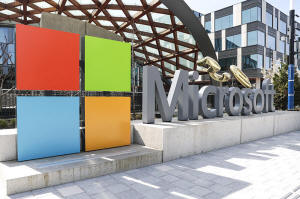Microsoft lays off about 3% of its workforce in what one executive calls
a 'day with a lot of tears'
[May 14, 2025] By
MATT O'BRIEN
Microsoft began laying off about 6,000 workers Tuesday, nearly 3% of its
entire workforce and its largest job cuts in more than two years as the
company spends heavily on artificial intelligence.
Hard hit was the tech giant's home state of Washington, where Microsoft
informed state officials it was cutting 1,985 workers tied to its
Redmond headquarters, many of them in software engineering and product
management roles.
Microsoft said the layoffs will be across all levels, teams and
geographies but the cuts will focus on reducing the number of managers.
Notices to employees began going out on Tuesday.
The mass layoffs come just weeks after Microsoft reported strong sales
and profits that beat Wall Street expectations for the January-March
quarter, which investors took as a dose of relief during a turbulent
time for the tech sector and U.S. economy.
“I think many people have this conception of layoffs as something that
struggling companies have to do to save themselves, which is one reason
for layoffs but it’s not the only reason,” said Daniel Zhao, lead
economist at workplace reviews site Glassdoor. “Big tech companies have
trimmed their workforces as they rearrange their strategies and pull
back from the more aggressive hiring that they did during the early
post-pandemic years.”

Microsoft employed 228,000 full-time workers as of last June, the last
time it reported its annual headcount. About 55% of those workers were
in the U.S.
Microsoft announced a smaller round of performance-based layoffs in
January. But the 3% cuts will be Microsoft's biggest since early 2023,
when the company cut 10,000 workers, almost 5% of its workforce, joining
other tech companies that were scaling back their pandemic-era
expansions.
Microsoft's chief financial officer, Amy Hood, said on an April earnings
call that the company was focused on “building high-performing teams and
increasing our agility by reducing layers with fewer managers.” She also
said the headcount in March was 2% higher than a year earlier, and down
slightly compared to the end of last year.
The layoffs are hitting all parts of Microsoft's business, including the
video game platform Xbox and the career networking site LinkedIn. Some
laid-off workers and the executives who made the cuts took to LinkedIn
to talk about them.
“This is the first time I’ve had to lay people off to support business
goals that aren’t my own," wrote Scott Hanselman, a vice president of
Microsoft's developer community. “I often have trouble separating my
beliefs with the system that I participate in and am complicit in. These
are people with dreams and rent and I love them and I want them to be
OK.”
He added: "This is a day with a lot of tears.”
The company didn't give a specific reason for the layoffs, only that
they were part of "organizational changes necessary to best position the
company for success in a dynamic marketplace.”
[to top of second column] |

A Microsoft sign and logo are pictured at the company's
headquarters, Friday, April 4, 2025, in Redmond, Wash. (AP
Photo/Jason Redmond, File)
 Microsoft has said it has been
spending $80 billion in the fiscal year that ends in June on
building data centers and other infrastructure it needs to develop
its artificial intelligence technology, though it has also scaled
back some of those projects. Those AI tools have been pitched as
changing the way people work, including in Microsoft's own
workplaces.
Microsoft CEO Satya Nadella told Meta CEO Mark Zuckerberg at an AI
event last month at Meta's headquarters that “maybe 20, 30% of the
code” for some of Microsoft's coding projects “are probably all
written by software.”
Even if AI is increasingly helping Microsoft software engineers,
however, doesn't necessarily mean it's a chief reason for laying
them off.
“When these big tech companies say that they’re trimming management
layers, that doesn’t really sound like it’s being driven by AI,”
Zhao said. “You’re not expecting ChatGPT to replace the manager.”
Instead, cutting management ranks can often reflect a broader
strategy.
“As companies grow quickly, you need to add managers who can
coordinate across teams or within teams,” Zhao said. “But it’s not
until things start to slow down that people start asking questions
about how necessary those roles are.”
Of the laid-off employees in Washington, about 1,500 worked in
person at Microsoft's offices and 475 worked remotely, according to
the notice the company sent to the state employment agency. Their
official last day will be in July.
After hiring sprees that started when the COVID-19 pandemic spiked
demand for online services, many tech companies are still in a
process of “coming back to Earth and trying to kind of rebalance
some things,” said Cory Stahle, an economist at Indeed, the job
listings website.

And while Microsoft isn't as directly affected by President Donald
Trump's wide-ranging tariffs as some of its peers, it must also
think more broadly about economic conditions that could play out
over the coming months and years.
“This could be an effort to think more long term,” Stahle said. “If
you have to go out and buy groceries and spend more on groceries and
produce that are more expensive due to tariffs, you maybe don’t have
as much discretionary income to spend on electronics or video game
systems.”
All contents © copyright 2025 Associated Press. All rights reserved |